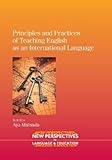Principles and Practices of Teaching English as an International Language / ed. by Aya Matsuda.
Material type: TextSeries: New Perspectives on Language and EducationPublisher: Bristol ; Blue Ridge Summit : Multilingual Matters, [2012]Copyright date: ©2012Description: 1 online resource (272 p.)Content type:
TextSeries: New Perspectives on Language and EducationPublisher: Bristol ; Blue Ridge Summit : Multilingual Matters, [2012]Copyright date: ©2012Description: 1 online resource (272 p.)Content type: - 9781847697035
- 9781847697042
- 428.0071 23
- PE1128.A2 P727 2012
- online - DeGruyter
| Item type | Current library | Call number | URL | Status | Notes | Barcode | |
|---|---|---|---|---|---|---|---|
 eBook
eBook
|
Biblioteca "Angelicum" Pont. Univ. S.Tommaso d'Aquino Nuvola online | online - DeGruyter (Browse shelf(Opens below)) | Online access | Not for loan (Accesso limitato) | Accesso per gli utenti autorizzati / Access for authorized users | (dgr)9781847697042 |
Frontmatter -- Contents -- Contributors -- Introduction: Teaching English as an International Language -- Part 1: Principles in Teaching English as an International Language -- 1. Selecting an Instructional Variety for an EIL Curriculum -- 2. Endonormative Models of EIL for the Expanding Circle -- 3. ELF, Intercultural Communication and the Strategic Aspect of Communicative Competence -- 4. The Politics of EIL: Toward Border-crossing Communication in and beyond English -- 5. Teaching Materials for English as an International Language -- 6. Assessing Proficiency in EIL -- 7. Teacher Education for EIL: Working toward a Situated Meta-praxis -- Part 2: Showcase of EIL Programs, Courses and Pedagogical Ideas -- 8. WE-Informed EIL Curriculum at Chukyo: Towards a Functional, Educated, Multilingual Outcome -- 9. English as an International Language (EIL): An Innovative Academic Program -- 10. World Englishes in a High School English Class: A Case from Japan -- 11. A WE-based English Communication Skills Course at a Turkish University -- 12. Participating in the Community of EIL Users Through Real-Time News: Integrated Practice in Teaching English as an International Language (IPTEIL) -- 13. EIL Activities and Tasks for Traditional English Classrooms -- Epilogue
restricted access online access with authorization star
http://purl.org/coar/access_right/c_16ec
This book critically examines current ELT practices vis-à-vis the use of English as an international lingua franca. It bridges the gap between theoretical discussion and the practical concerns of teaching English as an international language (EIL), and presents diverse approaches for preparing competent users of English in international contexts. Part 1 examines how the linguistic and functional varieties of English today complicate ELT, and suggests ways to address them effectively in an English language classroom. Part 2 showcases English courses and programs that are specifically based on the EIL perspective, illustrating how the issues addressed in Part 1 are realized in a real context. This section also presents a collection of EIL pedagogical ideas that have been developed and used successfully by English teachers across the world.
Mode of access: Internet via World Wide Web.
In English.
Description based on online resource; title from PDF title page (publisher's Web site, viewed 01. Dez 2022)


